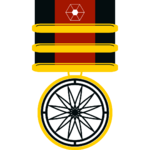Order of Odensburg: Difference between revisions
(Created page with "{{WIP}} The '''Order of Odensburg''' is Unirasia's second highest civilian and military decoration given to personalities who contributed to the country in wars or cultura...") |
No edit summary |
||
| Line 3: | Line 3: | ||
{{Infobox military award | {{Infobox military award | ||
| name = Order of Odensburg | | name = Order of Odensburg | ||
| image = [[File:Order of Odensburg.png| | | image = [[File:Order of Odensburg.png|150px]] [[File:Order of Odensburg blue variant.png|150px]] | ||
| alt = | | alt = | ||
| caption = | | caption = 20th century red variant and 21st century blue variant. | ||
| awarded_by = | | awarded_by = | ||
| country = [[Unirasia]] | | country = [[Unirasia]] | ||
| Line 27: | Line 27: | ||
| higher = [[Order of Claude Lenoir]] | | higher = [[Order of Claude Lenoir]] | ||
| same = | | same = | ||
| lower = | | lower = [[Order of Labour (Unirasia)|Order of Labour]] | ||
| related = | | related = | ||
| image2 = | | image2 = | ||
| Line 33: | Line 33: | ||
| caption2 = | | caption2 = | ||
}} | }} | ||
== History == | |||
=== Post World War I === | |||
After [https://simple.m.wikipedia.org/wiki/World_War_I World War I], the [[Unirasian government]] belatedly commissioned the medal in order to award Unirasian soldiers who fought alongside the {{flag|German Empire}} and rest of the components of the [https://simple.m.wikipedia.org/wiki/Central_Powers#:~:text=The%20Central%20Powers%20were%20a,Central%20Powers%20lost%20the%20war. Central Powers] such as the {{flagicon|Turkey}} [https://simple.m.wikipedia.org/wiki/Ottoman_Empire Ottoman Empire] and {{flagicon|Austria-Hungary}} [https://simple.m.wikipedia.org/wiki/Austria-Hungary Austria-Hungary]. The first pieces of the medals to be made were manufactured by the [[Imperial Company of Metals|ICM]], and distributed to those who fought for the country in July 12, 1928. It had the colors (red and black) of the Old Empire of Unirasia, with the symbol of the Unirasia Armed Forces on the center of it and the White Octagon in the ribbon, two of which still are in the modern version of the order. The government at the time ordered that only gold, ivory and obsidian could be used to make official medals and this still endures to this day. | |||
=== Post World War II === | |||
Just a very few people received the medal as Unirasia tried to stay neutral at all moments, choosing to profit from the war by selling weapons and supplies to both sides. | |||
Latest revision as of 20:21, 19 November 2020
This article is incomplete because it is pending further input from participants, or it is a work-in-progress by one author. Please comment on this article's talk page to share your input, comments and questions. Note: To contribute to this article, you may need to seek help from the author(s) of this page. |
The Order of Odensburg is Unirasia's second highest civilian and military decoration given to personalities who contributed to the country in wars or culturally. It is usually given by the Emperor of Unirasia but can also be given by the President of the Empire.
| Order of Odensburg | |
|---|---|
  20th century red variant and 21st century blue variant. | |
| Country | Unirasia |
| Type | Military and civilian decoration |
| Eligibility | Civilians and military personnel |
| Awarded for | For strong will of defense and love for the Unirasian people and for the Empire as well as substantial cultural contribution and representation of Unirasia |
| Status | Currently awarded |
| Motto | Dies gloriae |
| Statistics | |
| Established | July 12, 1928 |
| First awarded | August 25, 1928 |
| Last awarded | September 2, 2020 |
| Total awarded | 2,174 |
| Posthumous awards | 881 |
| Precedence | |
| Next (higher) | Order of Claude Lenoir |
| Next (lower) | Order of Labour |
History
Post World War I
After World War I, the Unirasian government belatedly commissioned the medal in order to award Unirasian soldiers who fought alongside the German Empire and rest of the components of the Central Powers such as the
Ottoman Empire and
Austria-Hungary. The first pieces of the medals to be made were manufactured by the ICM, and distributed to those who fought for the country in July 12, 1928. It had the colors (red and black) of the Old Empire of Unirasia, with the symbol of the Unirasia Armed Forces on the center of it and the White Octagon in the ribbon, two of which still are in the modern version of the order. The government at the time ordered that only gold, ivory and obsidian could be used to make official medals and this still endures to this day.
Post World War II
Just a very few people received the medal as Unirasia tried to stay neutral at all moments, choosing to profit from the war by selling weapons and supplies to both sides.